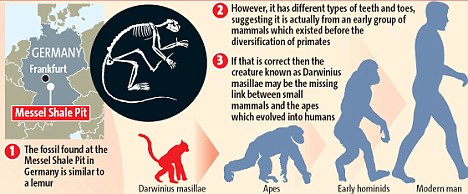Ida’s Namers Blew It
Posted by: Loren Coleman on May 22nd, 2009
Surprise, surprise. Yet another way to keep the circus going.
If you thought media coverage of Ida, the 47m-year-old primate, was about to die down, then don’t hold your breath.
The scientists behind the discovery named the new species Darwinius masillae, in honour of Charles Darwin’s 200th birthday. But it seems they may have been too hasty.
The species name is not valid thanks to a fabulous clash between the bureaucratic world of taxonomy and the newfangled phenomenon that is open source online publishing.
According to the International Commission on Zoological Nomenclature – and let’s face it, they should know – species names must be published in print before they are formally allocated. The Ida paper was published in an online journal run by the Public Library of Science.
The commission is evidently in the process of hauling its regulations into the 21st century, but for now, the old rules stand.
We can’t leave the poor fossilised scrap with an uncertain scientific name, so I feel obliged to come up with an interim solution until the Latin name has been confirmed. How about Maximus iocus? Or should that be Iocus maximus?
About Loren Coleman
Loren Coleman is one of the world’s leading cryptozoologists, some say “the” leading living cryptozoologist. Certainly, he is acknowledged as the current living American researcher and writer who has most popularized cryptozoology in the late 20th and early 21st centuries.
Starting his fieldwork and investigations in 1960, after traveling and trekking extensively in pursuit of cryptozoological mysteries, Coleman began writing to share his experiences in 1969. An honorary member of Ivan T. Sanderson’s Society for the Investigation of the Unexplained in the 1970s, Coleman has been bestowed with similar honorary memberships of the North Idaho College Cryptozoology Club in 1983, and in subsequent years, that of the British Columbia Scientific Cryptozoology Club, CryptoSafari International, and other international organizations. He was also a Life Member and Benefactor of the International Society of Cryptozoology (now-defunct).
Loren Coleman’s daily blog, as a member of the Cryptomundo Team, served as an ongoing avenue of communication for the ever-growing body of cryptozoo news from 2005 through 2013. He returned as an infrequent contributor beginning Halloween week of 2015.
Coleman is the founder in 2003, and current director of the International Cryptozoology Museum in Portland, Maine.











Ida, Schmida. Sheesh.
Hmmmmm. Idae schmidaensis.
How ’bout…oh, this has gotta be it…Darwinius beatscreationismadae.
Or Monkeysae lemurmaybeis.
I’ll keep working on it.
Well, at least they didn’t insist that Gutenberg had to set the type. Or that the Pope had to approve. Sometimes one takes progress where one can.
Didn’t it become official when someone hit “Print”? Just asking.
DWA:
Don’t you just love bureaucracy?
Red Tape: The Other White Meat!!! 🙂
Ah yes, yet another missing link. How about missinglinkusonemoretimeus ohitsjustanothermonkeyus sorryaboutthatus 😉
You nailed it, HoosierHunter.
This whole thing cracks me up-why is there to be considered any evicende of this being definitely in a line of humanity? No, this was merely a hype put together to ‘honor’ Darwin-after all, doesn’t anyone else seem it is awfully coinicdental to find this ‘missing link’ just in time for Darwin’s birthday? Evolutionists seem to often make incrdible finds just in time for certain deadlines. How is it that no one can accept that it was just a monkey-no more, no less? A different monkey, sure, but a monkey. If we followed the same line of reasoning that the evolutionists follow in man’s ‘ascent’, we could do it with animals alive now: we have little monkeys, and apes of varying sizes, and we have men of different facial structures and colors alive now, which, if we buried all the bones and found them a thousand years later, people would use, like today, to prove evolution. There are, currently in the human race, variances as vast in bone structures, due to racial and nutritional differences, which are as extreme as those found in the various ‘ancient’ proto-humans claimed to be from different evolutionary epochs. It’s all smoke and mirrors with no evidence.
Well, this should be a reminder to all of us – as if many of us even needed one – that there is science, which is virtually a perfect discipline.
And then there are scientists, who get hyped and excited and like publicity and coincidences and screaming “Happy Birthday!” just like the rest of us.
Darwinius happibirthdiensis! Darwinius heureuxanniversaris!
What the heck, toss him a goody bag, eh? Anything else fun and relevant being discovered this year?
It is a way cool find. Hard to call it a missing link, though, when you don’t even have a chain. Most of the ‘chain’ from proto-primates to us – practically all of it – is speculation. Intelligent speculation, to which considerable evidence seems to lend credence. But speculation. The number of times we’ve had to cobble changes and graftings and turnbuckles and cables to the family tree should speak to that, all by itself.
And to speculate like this, out of the box, is…well, it’s not science.
But it is, we should remember, scientists. Who are only human.
Don’t worry, fellas (and fems). Those of us who root for cryptids AND cool fossil finds can be very, VERY patient when we need to be. 😉